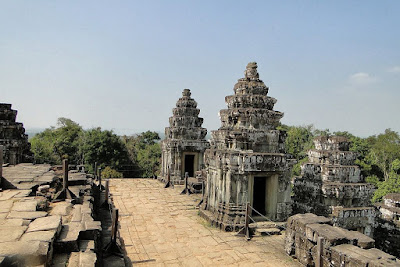[sigplus] Critical error: Image gallery folder sigplus/baphuon is expected to be a path relative to the image base folder specified in the back-end.
Constructed : Mid 11th century, 1060Temple Baphuon
Religion : Hindu
Temple Style : Baphuon
King Built : Udayadityavarman II ? 1050 – 1066 ?
Location : Angkor Thom, by leaving Bayon, on the left before arriving at the terrace of the elephants.
Religion : Hindu
Temple Style : Baphuon
King Built : Udayadityavarman II ? 1050 – 1066 ?
Location : Angkor Thom, by leaving Bayon, on the left before arriving at the terrace of the elephants.
Description : Baphuon is a huge temple-mountained located in the heart of Angkor Thom. Temple was built by Udayadityarvarman II was the most poorly constructed of all the temples in Angkor. From the remaining ruins, it is possible to see how imposing it was. This temple hill was dedicated to Shiva, but in its reliefs many motives from the Vishnu epic can be seen. Restoration work continues to be carried out on the Baphuon.
Baphuon is a little frustrating to pass in front of such a monument and not to be able to visit it. One of the center pieces of Angkor Thom, Baphuon is currently closed with the public for restoration and surely still for a long time. You can just make the turn of it. It is about an enormous work: a puzzle of more than 300.000 stones scattered on several hectares and of which some weigh several tons! Each stone is numbered and recorded in files burned during the war! The work which was stopped in 1970 consists today with all to reconstitute and the result should be equal to the challenge to be judged some by what is already visible.
It will thus be necessary to wait a certain time to have to be able to admire gigantic Buddha lying which is inside. This temple-mountain of which the sight in its top is, appears it, exceptional, was to be the central temple of second Angkor , intermediate stage between Phnom Bakheng and Bayon. What is presented today as an immense building site should become a major temple to visit after the end of work.
Temple Detail : The big temple where the court is located immediately on south side. Presently, France undertaking restoration, the large-sized crane is moving. As for being possible to visit, entering from Toumon, to the point of the aerial going/participating road ending. The inner part from that, it has become off limit. Because of that, walking outer circle generally, the back (west side) it turns, it means to return looking at the sleeping form of the explanation/releasing.
sourced:cambodia-tourism.org








